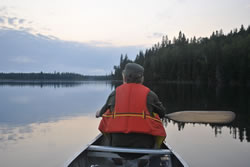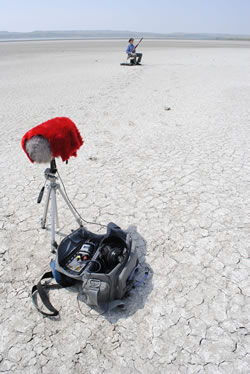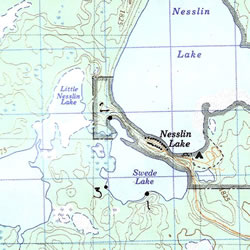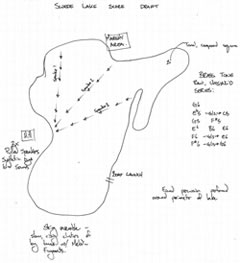Under Living Skies
Aural character in creative practice
The projects discussed in this paper are all based on two central questions: What is the sound of Saskatchewan? How can the unique aural character of this province be presented to an audience? The Under Living Skies project is composed of four individual creative and research periods dedicated to understanding the sounds of Saskatchewan and developing an understanding of aural character within several locations around the province.
The four project periods began with a composition reflecting the unique sound of Saskatchewan for the 2010 Lieutenant Governor’s Awards ceremony. This project involved collecting ambient field recordings from around the province as well as instrumental “interventions” with unique or interesting geological formations, including arid alkali flats, abandoned farm structures, Northern lakes and the distinct Cypress Hills eco-region in the Southwest corner of the province. The final composition featured an 8‑channel fixed media piece accompanied by a 7‑piece instrumental ensemble.
The following summer, I undertook a period of dedicated research performing site surveys and collecting a library of impulse responses allowing me to perform quantitative analysis of several locations in addition to the qualitative recordings made in 2010. The focus of this period of work was to find a location that not only featured a good dose of aural character, but also would serve as a good location for a future site-specific public presentation.
In the 2012 iteration, a site-specific recording project, the goal was to find a single location that creates a special relationship between space and sound. As opposed to bringing the sound of this location to a concert hall audience, I feel it is important to immerse the audience in the space itself, heightening the impact of their experience — both in the reception of the musical composition, and in their experience of the world as a sounding object.

Aural Character can be understood as the experience of “sound-in-space”. This is a qualitative combination of acoustic filtration (resulting in colouration) and temporal shifting (resulting in echo and reverberation). This idea of sound-in-space is closely related to what Barry Blesser and Linda-Ruth Salter refer to as aural architecture, and Bernie Krause calls geophony. Like aural architecture, aural character requires the ability of an individual to store information about relative locations — we cannot talk about the experience of a particular sounding space without being able to remember the sound of other spaces, and creating some sort of cognitive map to compare and contrast them. Additionally, aural character draws its roots from the definition of geophony: natural sounds springing from non-biological subcategories such as wind, water, earth movement and rain (Krause 2012, 39). However, aural character distances itself from these two terms in its application as a qualitative element in the compositional process, one dedicated to expression through musical means. My use of this term is similar to the common use of tone and timbre when used to discuss the comparative qualities of instrument sounds. When considering the compositional applications of tonal colouration and reverberation of a particular space, it is not too difficult a leap to make to begin considering aural character as an element of the compositional process, facilitating the use of specific places as meta-instruments. Blesser discusses the impact a sounding-space has on an instrument. To Blesser, the acoustic qualities of the performance space affect the sound of the instrument itself. He writes:
We can consider the musical space of a concert hall to be, not simply a place for musicians and listeners to gather for performances, but also an extension of the musical instruments played within it. (Blesser and Salter 2007, 135)
We cannot talk about the experience of a particular sounding space without being able to remember the sound of other spaces, and creating some sort of cognitive map to compare and contrast them.
My first compositional application of place as meta-instrument was in the 2010 piece Land of Singing Skies, for a mixed ensemble (violin, cello, double bass, 2 trumpets, bassoon, bass clarinet, 4 music boxes and percussion) and 8‑channel tape. This piece was commissioned by the Saskatchewan Arts Board for the 2010 Lieutenant Governor’s Awards and was premiered at the Conexus Arts Centre in Regina, Saskatchewan, on 21 September 2010. 1[1. Excerpts of the 2012 recordings and the entire 2010 performance can be found on the composer’s website under the “releases” tab. The title of the work was changed to Under Singing Skies for the CD release.]
Conceived as a duet between live instrumental / electronic ensemble and pre-recorded tape (composed from field and site-specific recordings), this composition uses electroacoustic technology and contemporary compositional approaches to blur the distinctions between electroacoustic and classical composition. This piece blends natural, traditional and contemporary means of sound generation to create an aural portrait of the province. Made up of four sections, Resource, Transportation, City and Country, this work seeks to present as wide a selection as possible of the sounds and spaces that make Saskatchewan unique.
The compositional process mixed elements of soundscape composition as well as contemporary jazz and classical compositional styles. In developing the piece, I relied heavily on the field recorded sounds — reflecting the rhythmic, harmonic or melodic structures that were drawn out of the original field recordings, creating new melodies singing from the places themselves.
The second movement, City, features a linear representation of a thundershower moving across the audience from the Northeast to the Southwest. As the shaker eggs fade, the first peal of thunder is heard. The primary instrumentation in this movement is a group of four DIY music boxes playing a 4‑part lullaby while the storm rages overhead. The City section was intentionally quiet and relatively pastoral in order to stay away from the overdone, high-intensity hustle and bustle many may conceive as being part of a city soundscape.

The 2011 research period was spent visiting several sites around the province, trying to determine a suitable site for the 2012 recording and 2013 live presentation iterations, as well as building a library of impulse responses from locations around the province. The goal of this library was to remove some of the subjectivity from the understanding of aural character. By collecting and analyzing these impulse recordings, it is possible to isolate resonant frequencies, and, using convolution reverb processing, to compare locations (possibly hundreds of kilometres apart) instantly — removing time as a factor in the analysis and comparison of previously disparate locations.
My recording team also performed (and recorded) improvised performative interventions (voice and instrumental), interacting with the site aimed at highlighting the particular characteristics and acoustic nuances of each location (Fig. 2). This combination of location-specific recording and site-specific performance allowed me to develop a performance lexicon for use in composing the final site-specific performance event — collecting source material to assist in off-site planning and composing, as well as allowing the team to determine suitability of the site for the final production.

A factor in the decision to use a particular site or not extended beyond a pure interest in the spatial meta-instrument’s character, but the site needed to be accessible (reasonably), and the ideal site needed to have access to nearby accommodation such as a town or campsite and other amenities to support the influx of listeners / participants for the future performance iteration.
After selecting a site (Swede Lake in Northern Saskatchewan) I was able to progress to the 2012 composition and recording stage of the project. This stage focused on the creation of site-specific compositions and recordings, and applied the idea of place performing as meta-instrument most directly. Using the location data and impulse responses collected in 2011, I performed preliminary studio work: analyzing the impulses, creating scores and audio sketches. Then, in August and September of 2012, I applied these scores and sketches in the field, creating site-specific audio and video recordings of the in situ performances. The first period of this project involved extensive studio preparation, including spectral analysis of each impulse response to determine the effects of tonal colouration — extrapolating the resonant frequencies present within each location, followed by the generation of scores. Using the library of impulse responses, I was able to give each section of the composition a “dry run” in the studio, effectively composing for a specific site, without needing to be physically present on-site.

These scores were performed and recorded during extended visits to Swede Lake, allowing my team to experiment with the full sonic potential of each site. The goal of these recording sessions was to create a piece of work that seamlessly blends musical instruments with the unique sonic character of these locations, in particular the echo and acoustic filtration (including resonant frequencies) naturally found across a calm Northern lake.
During the recording period, I used a variety of methods to achieve this goal. Beginning with the pre-composed scores, each section of the piece was further developed on-site. By shifting tonal centres, developing new compositional structures and re-positioning musicians, a collaborative environment developed that allowed the entire team to offer input on how to take full advantage of their instruments within this particular sounding space.
As this project evolved, so has my understanding of aural character and its application in the compositional process — primarily as a means of understanding the sonic colouration of a particular place, allowing these colourations or other acoustic phenomenon to be utilized in the compositional process, specifically with the understanding of all performance spaces existing as meta-instruments.
Bibliography
Blesser, Barry and Linda-Ruth Salter. Spaces Speak, Are You Listening? Experiencing Aural Architecture. Cambridge MA: The MIT Press, 2007.
Krause, Bernie. The Great Animal Orchestra: Finding the origins of music in the world’s wild places. New York NY: Little, Brown and Co., 2012.
Social top